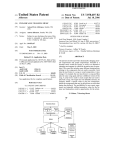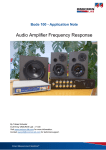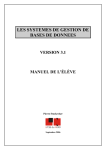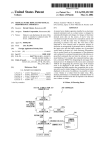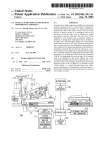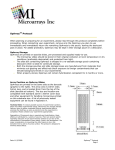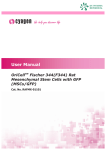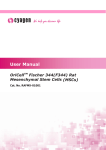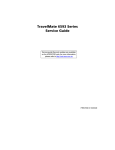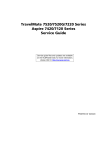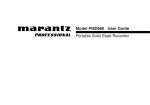Download Keyboard musical instrument displaying depression values of
Transcript
US007361829B2 (12) United States Patent (10) Patent N0.: (45) Date of Patent: Uehara (54) KEYBOARD MUSICAL INSTRUMENT 6,160,213 A * DISPLAYING DEPRESSION VALUES OF PEDALS AND KEYS 6,388,181 B2 (JP) (*) Notice: Apr. 22, 2008 Arnold et a1. .............. .. 84/615 5/2002 Moe FOREIGN PATENT DOCUMENTS (75) Inventor: Haruki Uehara, ShiZuoka-ken (JP) (73) Assignee: Yamaha Corporation, ShiZuoka-ken 12/2000 US 7,361,829 B2 CN JP JP JP 1135627 05-173546 06-027938 2003-255929 11/1996 7/1993 2/1994 9/2003 Subject to any disclaimer, the term of this patent is extended or adjusted under 35 U.S.C. 154(b) by 511 days. * cited by examiner (21) Appl. No.: 11/077,425 Primary ExamineriJeifrey Donels (22) Filed: PLC (74) Attorney, Agent, or FirmiHamess, Dickey & Pierce, Mar. 10, 2005 (65) Prior Publication Data US 2005/0204908 A1 (57) ABSTRACT Sep. 22, 2005 A keyboard musical instrument supports lessons in practic (30) Foreign Application Priority Data Mar. 16, 2004 (51) (52) (58) (JP) ........................... .. 2004-074031 Int. Cl. G10H 1/32 G10H 3/00 G10H 1/00 G09B 15/00 G09B 15/02 (2006.01) (2006.01) (2006.01) (2006.01) (2006.01) US. Cl. ..................................... .. 84/746; 84/477 R Field of Classi?cation Search ................ .. 84/721, 84/746, 470 R, 477 R, 478 See application ?le for complete search history. (56) References Cited ing musical performance on a keyboard to alloW users to learn musical performance expressions. In accordance With a teacher’s model performance, performance data represent ing operations of keys of the keyboard, pedal depression data representing operations of pedals, and damper position data representing positions of dampers in action mechanisms are created and recorded on recording media such as ?exible disks. When a student plays the keyboard musical instru ment, the performance data, pedal depression data, and damper position data are reproduced by means of the recording media, so that they are displayed on the screen of a display, Wherein the prescribed keys to be depressed are sequentially displayed in a piano roll form based on the performance data, and Wherein depression Values of the pedals and positions of the dampers are displayed based on the pedal depression data and damper position data. U.S. PATENT DOCUMENTS 6,084,167 A * 7/2000 TIME Akimoto et a1. ........ .. 84/477 R mAgdb DEPRESSION -—> 5 Claims, 6 Drawing Sheets U.S. Patent Apr. 22, 2008 Sheet 1 0f 6 US 7,361,829 B2 FIG.1 Ha L '\ f /H 100 13A 16 ‘* 13B 13C U.S. Patent Apr. 22, 2008 Sheet 2 0f 6 US 7,361,829 B2 FIG. 2 8a 8 130 /1 4 8a DISPLAY 7 8 w 13A U.S. Patent Apr. 22, 2008 Sheet 3 0f 6 US 7,361,829 B2 Ba é/Ba @\ Ba “11" '[ME wAgdb WIT Ba }G4 185g DEPRESSION ‘--> ‘IS/kpi] £01 )2 138p FIG. 3B Ba Ba :5: WIT v Ba [I }G3 T I ME dg D l STAN CE d2 G5 U.S. Patent Apr. 22, 2008 Sheet 4 0f 6 US 7,361,829 B2 FIG.4 MAIN ROUTINE I START ‘ ) [~81 < SETUP OPERATION ? w ,YES 82 SETUP PROCESS < START RECORDING ? ,YES /"$4 START RECORDING INTERRUPT PROCESS 4 , < NO STOP RECORDING ? > ,YES /'S6 STOP RECORDING INTERRUPT PROCESS 87 P CREATE PERFORMANCE DATA OF PRESCRIBED FORMAT BASED ON DATA OF PERFORMANCE RECORDING BUFFER; AND STORE THEM IN MEMORY (START AUTOMATIC PERFORMANCE ? / 1153 /S9 ST'ART AUTOMATIC PERFORMANCE INTERRUPT PROCESS $10\ I*—————--,;,—; ( STOP AUTOMATIC PERFORMANCE ?)—S H STOP AUTOMATIC PERFORMANCE INTERRUP; PROCES OTHER PROCESSES $12 I --N-9<ENO 0F MAIN ROUTINE YES I I END I 313 U.S. Patent Apr. 22, 2008 US 7,361,829 B2 Sheet 5 0f 6 FIG.5 RECORDING INTERRUPT PROCESS /—s21 < KEY EVENT ? >—N° YES I, s22\ STORE KEY EVENT DATA AND TIMING DATA IN PERFORMANCE RECORDING BUFFER 823k PEDAL EVENT ? 3 NO , YES I, 824w STOREv PEDAL EVENT DATA AND TIMING DATA IN PERFORMANCE RECORDING BUFFER I STORE DAMPER POSITION DATA AND TIMING DATA IN DISPLAY RECORDING BUFFER r825 I STORE PEDAL DEPRESSION DATA AND r826 TIMING DATA IN DISPLAY RECORDING BUFFER @ U.S. Patent Apr. 22, 2008 US 7,361,829 B2 Sheet 6 0f 6 FIG6 AUTOMATIC PERFORMANCE INTERRUPT PROCESS S31 ACTION DISPLAY PEDAL DISPLAY MODE OR ACTION DISPLAY MODE PEDAL DISPLAY A f 332 I DISPLAY ANIMATIONS IN AREA G1 BASED ON PEDAL DEPRESSION DATA AT PRESENT TIMING DISPLAY GRAPHS IN AREA v G2 BASED .ON PEDAL DEPRESSION DATA BELONGING TO TIME LENGTH BETWEEN PRESENT TIMING AND DISPLAY TIMING ‘ I LINE OF COPY AND SCROLL UNIT LENGTH IN AREA G4 S36 f’- 834 DISPLAY GRAPHS IN AREA G5 BASED ON DAMPER POSITION DATA BELONGING To TFLHESIEEIHGWMTEFEEN AND D|$pLAY T|M|NG I fsss EVENT DATA AT DISPLAY TIMING '? NO /-s37 STORE ALL EVENT DATA AT DISPLAY TIMING IN DISPLAY BUFFER J '1 I READ SINGLE EVENT DATA FROM DISPLAY BUFF ER S39 NOTE-OFF ? YES S41 \ DISPLAY SEGMENT OF NOTE BAR ON LINE AT THE CORRESPONDING KEY POSITION L CLEAR EVENT DATA ERASE SEGMENT OF NOTE BAR ON LINE FROM THE CORRESPONDING KEY POSITION V543 Q NO ROCESSING OF ALL EVENT DATA IN DISPLAY BUFFER COMPLETED ? YES 845 844 I v EVENT DATA NO AT PRESENT TIMING ? YES STORE ALL EVENT DATA AT PRESENT TIMING IN PERFORMANCE BUFFER PLAY AUTOMATIC PERFORMANCE BASED ON DATA OF PERFORMANCE 'BUFFER P ( RETURN ) /-s47 US 7,361,829 B2 1 2 KEYBOARD MUSICAL INSTRUMENT DISPLAYING DEPRESSION VALUES OF PEDALS AND KEYS tion regarding ?ngering guidance, pedal operations, and damper positions, all of Which realiZe improvements for musical techniques and musical expressions, so as to effec tively support lessons in practicing musical performance. BACKGROUND OF THE INVENTION In a ?rst aspect of the invention, a keyboard musical instrument is equipped With a control unit and a display, Which shoWs a keyboard display section for displaying operation states of keys of a keyboard based on performance 1. Field of the Invention This invention relates to keyboard musical instruments having ?ngering guidance functions, Which guide users to data indicating ?ngering guidance for sequentially designat depress keys based on performance data so that conditions and operations for manual performance on keyboards are ing keys to be depressed, and a pedal display section for displaying operation states of pedals based on pedal depres sion data indicating depression values of pedals to be displayed. depressed. This application claims priority on Japanese Patent Appli In the above, the depressed keys are sequentially dis played in a piano roll form, Wherein note bars indicating note lengths are scrolled With respect to animated images cation No. 2004-74031, the content of Which is incorporated herein by reference. 2. Description of the Related Art representing the keys of the keyboard in the progression of musical performance. Conventionally, various types of technologies have been developed With regard to ?ngering guidance displays, Which guide users to depress keys in musical performance in progress When practicing keyboard musical instruments. For example, Japanese Patent Application Publication No. H05 20 Which shoWs a keyboard display section for displaying operation states of keys of a keyboard based on performance 173546 discloses a performance guidance device for a data indicating ?ngering guidance for sequentially designat keyboard musical instrument, in Which tWo-colored LEDs (e. g., red and green LEDs) are arranged on the upper portion of a keyboard and are turned on to designate keys to be depressed based on musical tune data. Speci?cally, each key is designated by a green light just before it should be depressed; and each key is designated by a red light just at the timing at Which it should be depressed, Whereby it is possible to reduce delays regarding a user’s manual opera In a second aspect of the invention, a keyboard musical instrument is equipped With a control unit and a display, 25 ing keys to be depressed, and an action display section for displaying operation states of selected parts of action mecha nisms, Which transmit operations of the keys to strings in the keyboard, in a time-series manner. 30 tions With regard to the precise key-depression timing. Generally, such ?ngering guidance is realized by turning on In the above, the selected parts are dampers for damping vibrations transmitted to the strings in the action mecha nisms, so that the action display section shoWs positions of the dampers in the progression of musical performance. BRIEF DESCRIPTION OF THE DRAWINGS LEDs, Which are arranged in proximity to keys of the keyboard, thus designating keys to be depressed. Speci? cally, ?ve LEDs are installed in a keyboard musical instru ment so as to shoW the positioning of the user’s ?ve ?ngers on a keyboard. Alternatively, OPEN/CLOSE indicators are installed in a keyboard musical instrument so as to shoW the 35 reference to the folloWing draWings, in Which: FIG. 1 is a perspective vieW shoWing the exterior appear ance of a player piano in accordance With a preferred positioning of user’s ?ve ?ngers on a keyboard. Japanese Patent Application Publication No. H06-27938 discloses a pedal operation display device for a piano, Which is designed to cope With di?iculties that players experience 40 FIG. 3A shoWs an example of a displayed image in a pedal cal performance on a piano. Speci?cally, an automatic 45 action display mode; FIG. 4 is a ?owchart shoWing a main routine of a control program executed by a microcomputer installed in the player 50 di?icult for users to learn sophisticated musical performance and musical expressions, closely related to key-depression FIG. 6 is a ?oWchart shoWing an automatic performance 55 interrupt process incorporated into the main routine shoWn in FIG. 4. keys to be depressed. In addition, musical scores merely shoW ON/OFF symbols regarding pedals, Which make it DESCRIPTION OF THE PREFERRED EMBODIMENT very di?icult for users to learn musical performance and musical expressions using pedal operations. This problem occurs in the conventional technology disclosed in Japanese Patent Application Publication No. H06-27938, Which is piano; FIG. 5 is a ?owchart shoWing a recording interrupt process incorporated in the main routine shoWn in FIG. 4; and touch intensities) on keys of keyboards. Therefore, it is very intensities, by merely playing keyboard musical instruments While Watching ?ngering guidance displays for designating display mode; FIG. 3B shoWs an example of a displayed image in an computer screen on Which periods and timings for operating pedals are displayed based on performance data. In keyboard musical instruments such as pianos, musical performance and musical expressions are greatly in?uenced by pedal operations and key-depression intensities (or key embodiment of the invention; FIG. 2 is a block diagram shoWing hardWare con?gura tions interconnected With essential parts of a keyboard of the player piano shoWn in FIG. 1; When directly Watching pedals being operated during musi performance piano (e.g., a player piano) is equipped With a These and other objects, aspects, and embodiments of the present invention Will be described in more detail With 60 This invention Will be described in further detail by Way designed to merely indicate the timings for pedal operations. of examples With reference to the accompanying draWings. SUMMARY OF THE INVENTION ance of a keyboard musical instrument in accordance With a FIG. 1 is a perspective vieW shoWing the exterior appear 65 It is an object of the invention to provide a keyboard musical instrument that displays various pieces of informa preferred embodiment of the invention, Wherein the key board musical instrument is an upright player piano, Which has a keyboard 12 in the middle portion of a piano housing US 7,361,829 B2 3 4 (or a casing) 11, Which is equipped With a soft pedal 13A, a mu?ler pedal 13B, and a loud pedal 13C all arranged in the lower portion. Though the explanation Will be made on the upright piano, the present invention is applicable to a grand display operation states regarding the keyboard 12 and the pedals 13 as Well as operation states regarding the dampers (i.e., positions of dampers) on the screen 14a. This alloWs the student to experience ?ngering guidance With reference piano. For the sake of convenience, the soft pedal 13A, mu?ler pedal 13B, and loud pedal 13C are collectively visually recogniZe operation states of pedals and dampers, referred to as pedals 13. The functions of the pedals 13 are Which are di?icult to vieW directly Without the display 14. to operation states of the keyboard 12. Also, the student can similar to those of pedals installed in conventionally knoWn Thus, it is possible to realiZe improvements in the student’s upright pianos. That is, When the soft pedal 13A is piano lessons. depressed, strokes of hammers are reduced in poWer so as to In addition, the player piano can produce student’s per formance data regarding the student’s piano practice, Which Weaken the intensities in Which the hammers strike strings, thus reducing the volumes of sounds. When the mu?ler pedal 13B is depressed, a felt mu?ler member (not shoWn) can be recorded on a ?exible disk. Using such a ?exible disk, the player piano reproduces the student’s performance data, thus realiZing automatic performance and displaying various is introduced betWeen the hammers and the strings so as to reduce striking forces applied to strings, thus reducing the volumes of sounds. When the loud pedal 13C is depressed, pieces of information on the screen 1411 of the display 14. This makes it possible for the teacher to grasp the details of vibrations of strings being struck With hammers are sus the student’s piano practice. The player piano of the present tained for a While so as to cause resonation of other strings, embodiment is designed to realiZe tWo modes, Which can be thus increasing volumes of sounds. sWitched betWeen With regard to displayed contents, i.e., a A screen 1411 of a display 14 is attached to the center area 20 pedal display mode for displaying operation states regarding of an upper front board 11a, Which is arranged in the upper the keyboard 12 and the pedals 13, and an action display portion of the piano housing 11. The display 14 can be arranged independently of the piano housing 11. The screen 1411 of the display is placed above a music stand (not mode for displaying operation states regarding the keyboard 12 and positions of dampers. shoWn), Which is made on a fall board of a piano, and the center line of the screen 1411 is roughly aligned to match the center line of the music stand. In this regard, the screen 1411 25 of the player piano shoWn in FIG. 1. The folloWing descrip tion is given With respect to a key 1 of the keyboard 12, of the display 14 may be placed on a top board of the piano. For the display 14, it is possible to use various types of displays, such as CRT displays, liquid crystal displays, and 30 and a rear support 40 are arranged on a keybed 11b. The front support 411 and the balance support 4b are intercon 35 display; hence, the display 14 can be realiZed by a portable display or a personal digital assistant (PDA). support 40. When the front portion of the key 1 is depressed, the key 1 rotatably moves about the supporting position peripheral circuits is arranged in the loWer right side under disks (e.g., ?oppy disks). For example, the control unit 100 is capable of recording performance data that are created by playing the player piano and is also capable of reproducing 40 45 performance data that are already recorded on ?exible disks so as to realiZe automatic performance on the player piano. That is, the player piano of the present embodiment can serve various purposes, Wherein students practice piano lessons, and teachers play model performance. When a nected via a metal support assembly 4d. The front portion of the key is arranged above the front support 4a; the center portion of the key 1 is mounted on the balance support 4b; and the rear portion of the key 1 is mounted on the rear A control unit 100 including a microcomputer and its a keybed 11b of the keyboard 12. The control unit 100 has a ?exible disk drive (FDD) 10, Which enables recording and playback (or reproduction) of musical data by use of ?exible Which is a White key. Of course, a black key has a similar structure to the White key. The keyboard 12 has an action mechanism 3 that transmits the motion of the key 1 to a string (or strings) 2. Afront support 4a, a balance support 4b, plasma displays. The position of the screen 1411 of the display 14 is not necessarily limited to the aforementioned position aligned to match the center line of the music stand, Wherein the display 14 can be placed on either side of the music stand. The display 14 is not limited to a build-in type FIG. 2 is a block diagram shoWing hardWare con?gura tions interconnected With essential parts of the keyboard 12 corresponding to the balance support 4b Within a vertical plane in FIG. 2. A key sensor 5 is ?xed onto the metal support assembly 4d. The key sensor 5 detects depression of the key 1, key-depression velocity, and key-depression pressure, so as to produce a key-on signal (or a key-o? signal), an initial touch signal, and an after-touch signal. These signals are collected to form a key-depression signal, Which is supplied to a control circuit CC of the control unit 100. Akey solenoid 6 is arranged in proximity to the rear support 40. The key 50 teacher plays the keyboard 12, the player piano produces key operation data (representing keycodes, touch data, key-on solenoid 6 is driven by a servo circuit 611 under the control of the control circuit CC. In an automatic performance, When the key solenoid 6 is driven, the rear portion of the key events, and key-o? events With regard to musical notes), 1 is lifted up so as to realiZe an automatic depression of the pedal operation data (representing types of pedals being key 1, Which is similar to manual depression of the key 1. operated, and amounts of depressions applied to pedals), and operation state data (representing motions being detected 55 For the sake of convenience, FIG. 2 shoWs a single group of three elements, i.e., the key sensor 5, the key solenoid 6, and With respect to prescribed parts of an action mechanism; the servo circuit 6a. Of course, these elements are arranged speci?cally, in the present embodiment, damper position for each of the keys (e.g., eighty-eight keys) of the keyboard data), all of Which are collected together to form perfor 12. A pedal sensor 7 and a pedal solenoid 8 are arranged in mance data, Which are recorded on a ?exible disk in a 60 prescribed format. When a ?exible disk is put into the control unit 100, the player piano reproduces the teacher’s performance data representing the teacher’s model perfor mance so as to realiZe automatic performance, according to Which a student can practice piano lessons. Based on the teacher’s performance data being repro duced, the control unit 100 controls the display 14 so as to 65 proximity to each of the pedals 13A, 13B, and 13C. The pedal sensor 7 detects the depression of the corresponding pedal 13 so as to produce a pedal operation signal repre senting a depression value (i.e., a depression stroke), Which is supplied to the control circuit CC. The pedal solenoid 8 is driven by a servo circuit 811 under the control of the control circuit CC, so that the corresponding pedal 13 is driven to US 7,361,829 B2 5 6 realize an automatic depression thereof, Which is similar to the pedals 13. In addition, the graphs 13Ag, 13Bg, and 13Cg manual depression of the pedal 13 When depressed by a are collectively scrolled doWnWards in the progression of user’s foot. Similar to conventionally knoWn action mechanisms automatic performance. adapted to acoustic pianos, the action mechanism 13 adapted to the player piano includes a Whippen ‘a’, a damper spoon ‘b’, a damper lever ‘c’, a damper ‘d’, a jack ‘e’, a pad ‘f’, The animations 13Ap, 13Bp, and 13Cp are not necessarily 5 displayed and controlled in response to the automatic per formance, and they can be displayed and controlled in response to outputs of the pedals 13, Which alloWs pedal operations of the teacher’ s model performance to be visually a hammer shank ‘g’, and a hammer ‘h’. When the key 1 is recognized on the screen 1411 of the display 14. The area G3 shoWs a schematic pattern of the keyboard 12 of the player piano; and area G4 shoWs note bars Ba, Which manually depressed (or it is driven by the solenoid 6), a capstan 1a planted at the rear end portion of the key 1 presses up the Whippen a so that the damper spoon b drives form displayed elements of ?ngering guidance, in a piano the loWer end of the damper lever c, Whereby the damper d separates from the string 2. At this time, the jack e drives the roll form. Such a piano roll display is similar to conven pad f so as to cause rotation With regard to the hammer shank performance data, Wherein note bars Ba sequentially move g and the hammer h, Which thus strikes the string 2. The player piano of the present embodiment has a damper position sensor 9 for detecting the operation state of the damper d. For example, the damper position sensor 9 may be realized by a re?ection-type photo sensor, Which has a tionally knoWn piano roll displays for displaying contents of doWnWards from the top to the bottom in the area G4 in accordance With the progression of automatic performance, and they designate keys to be depressed, Which are displayed just beloW them in the area G3. When the loWer end of the 20 the backside of a damper Wood d1 of the damper d. That is, When the damper d operates, the damper position sensor 9 detects a relative position of the damper d With respect to the ends do not match the bottom of the area G4 notify a user of key-depression timings of the corresponding keys in 25 string 2, thus producing a position detection signal, Which is then supplied to the control circuit CC. The control unit 100 includes an operation panel 20 in addition to the ?exible disk drive (FDD) 10. The operation note bar Ba moves doWn to match the bottom of the area G4, it shoWs the key-depression timing With regard to the corresponding key. In addition, note bars Ba Whose loWer sensing WindoW that is positioned opposite to the damper d With respect to the string 2 and is also positioned opposite to advance. Furthermore, the length of the note bar Ba desig nates a time length ranging from the key-on timing to the key-off timing. The present embodiment performs processing regarding the piano roll display, as folloWs: such as an operator for designating start/ stop of automatic First, When performance data subjected to automatic performance are selected (or designated), the microcom puter analyzes and extracts a prescribed amount of perfor performance, an operator for designating start/stop of per mance data belonging to a prescribed time length, Which 30 panel 20 has various operators (e.g., sWitches and controls) formance recording, and an operator for sWitching over the pedal display mode and action display mode as Well as other operators used for settings and the like. The control circuit CC is constituted by a microcomputer, Which executes 35 to the prescribed time length in the automatic performance are displayed in the area G4. When an interrupt occurs in the control programs stored in a ROM (not shoWn) so as to perform various controls With regard to automatic perfor mance, display, and read/Write operations of performance 40 data using the ?exible disk drive 10. FIGS. 3A and 3B shoW examples of displayed images on the screen 1411 of the display 14. Speci?cally, FIG. 3A shoWs a displayed image in the pedal display mode; and FIG. 3B shoWs a displayed image in the action display mode. The displayed in the form of a rectangular segment, Which is constituted by pixels representing the corresponding note length and pixels representing the Width of the correspond 45 ing key displayed in the area G3. Based on performance data corresponding to the timing (hereinafter, referred to as “display timing”), Which is subsequent to the interrupt timing of the automatic performance (hereinafter, referred to as “present timing”) by the prescribed time length corre 50 13 illustrated in plan vieW; speci?cally, three animations 13Ap, 13Bp, and 13Cp are displayed in correspondence With the soft pedal 13A, the mu?ler pedal 13B, and the loud pedal 13C respectively. In FIG. 3A, it shoWs a pedal operation state in Which the soft pedal 13A and the loud pedal 13C are processing of the automatic performance that is started, a line L for a single scroll operation is copied to the top position of the area G4, and all note bars displayed there under are scrolled by one line. Herein, each note bar Ba is displayed image of FIG. 3A regarding the pedal display mode is divided into four areas G1-G4, Wherein a pedal display section consists of the areas G1 and G2, and a keyboard display section consists of the areas G3 and G4. The area G1 shoWs animations representing the three pedals corresponds to the vertical Width of the area G4 on the screen 1411 of the display 14, so that all note bars belonging sponding to the height of the area G4, segments of note bars corresponding to note-on events are displayed in relation to the line L displayed at the top position of the area G4, but segments of note bars corresponding to note-off events are erased from the area G4. The aforementioned process is 55 repeatedly performed every time an interrupt occurs in the not depressed, but the mu?ler pedal 13B (represented by the animation 13Bp) is depressed. Each of the animations 13Ap, processing of the automatic performance. Thus, note bars Ba 13Bp, and 13Cp are vertically deviated in position so as to shoW a depression value thereof. The animations 13Ap, 13Bp, and 13Cp are varied in response to operations of the the progression of the automatic performance. In the action display mode shoWn in FIG. 3B, the display are scrolled doWnWards in the area G4 in accordance With 60 pedals 13 in the progression of automatic performance. The area G2 shoWs graphs 13Ag, 13Bg, and 13Cg that are displayed to shoW depression values of the pedals 13A, 13B, and 13C With respect to time, Wherein the horizontal axis represents the depression value, and the vertical axis repre 14 displays areas G3-G5 on the screen 14a, Wherein an action display section corresponds to the area G5, and a keyboard display section consists of the areas G3 and G4. The area G5 shoWs graphs dg, each of Which shoWs time related variations of the position of the damper d of the sents time. Herein, curves or lines draWn in the graphs shoW corresponding key 1. In the graphs dg, the horizontal axis represents the distance betWeen the string 2 and the damper time-related variations of depression values With respect to d, and the vertical axis represents time. Hence, curves or 65 US 7,361,829 B2 7 8 lines of the graphs dg show time-related variations of distances with respect to the corresponding keys. These graphs dg are collectively scrolled downwards in the pro possible to start the recording interrupt process shown in FIG. 5 at the prescribed interrupt timing corresponding to the tempo that is manually or automatically set up. In step S5, the microcomputer monitors whether the recording is to gression of the automatic performance. Next, detailed descriptions will be given with respect to the graphs 13Ag, 13Bg, and 13Cg, which are displayed in stop in response to an operation event regarding the record ing start/ stop operator. The present embodiment is designed to neglect operation events regarding other operators in the operation panel 20 during the recording of performance data until the recording is stopped. When the recording is the area G2 shown in FIG. 3A, and the graphs dg, which are displayed in the area G5 shown in FIG. 3B. Pedal depression data representing depression values, which are applied to the pedals 13 and are detected by the stopped, the microcomputer stops the recording interrupt pedal sensors 7, and damper position data representing positions of the dampers d, which are detected by the process in step S6; then, the ?ow proceeds to step S7. In step S7, the microcomputer creates performance data of a pre damper position sensors 9, are recorded in correspondence with prescribed clock timings of performance data. When an interrupt occurs in the processing of the automatic perfor scribed format based on previous data that are stored in a performance recording buffer (not shown) in the recording interrupt process; then, it writes them into memory (e.g., internal RAM). Thereafter, the ?ow proceeds to step S8. mance, the aforementioned graphs are created based on performance data corresponding to the prescribed time length between the present timing (corresponding to the In step S8, a decision is made as to whether or not interrupt timing) and the display timing, whereby they are written over in the areas G2 and G5 respectively. As a result, 20 the graphs 13Ag, 13Bg, and 13Cg, and the graphs dg are sequentially scrolled downwards in the progression of the directly proceeds to step S12. If the automatic performance is started, the ?ow proceeds to step S9 for starting the automatic performance interrupt process; then, the ?ow automatic performance. In order to avoid interference between displayed regions between adjacent key regions on the screen 1411, the graphs dg are displayed in the area G5 only with respect to note-on events. 25 that is automatically or manually set up. In step S10, the microcomputer monitors whether the automatic perfor described with reference to FIGS. 4 to 6. FIG. 4 is a 30 mance is to stop in response to an operation event regarding the automatic performance start/ stop operator. In this case, the microcomputer neglects operation events regarding interrupt process. The main routine shown in FIG. 4 mainly describes the processing for the operation panel 20, wherein step S1 is related to setup operation in which a decision is proceeds to step S10. As a result, it is possible to start the automatic performance interrupt process shown in FIG. 6 at the prescribed interrupt timing corresponding to the tempo Next, details of the controlling and processing adapted to the player piano of the present embodiment will be ?owchart showing a main routine of control programs; FIG. 5 is a ?owchart showing a recording interrupt process; and FIG. 6 is a ?owchart showing an automatic performance automatic performance is started in response to an operation event regarding an automatic performance start/ stop opera tor. If the automatic performance is not started, the ?ow 35 other operators in the automatic performance until the automatic performance is stopped. When the automatic performance is stopped, the ?ow proceeds to step S11 for made as to whether or not a setup operation is made by a user stopping automatic performance interrupt process; then, the of the player piano. If “NO”, the ?ow proceeds to step S3. If “YES”, the ?ow proceeds to step S2 in which the ?ow proceeds to step S12. In step S12, the microcomputer performs other processes. In step S13, a decision is made as to whether or not the main routine is terminated in response microcomputer performs setup processes corresponding to various setup operations made by the user; then, the ?ow proceeds to step S3. In the setup process, for example, the 40 microcomputer selectively sets either a left register or a right which are created and recorded in advance, so that the register (because all the keys of the keyboard 12 are divided into two groups, i.e., right and left registers) with respect to the areas G3, G4, and G5 on the screen 14a. Herein, a desired register is selected in response to a musical tune performance data are written into ?exible disks, for 45 example. In the recording interrupt process shown in FIG. 5, the ?ow ?rstly proceeds to step S21 in which a decision is made subjected to automatic performance and is selectively dis played on the screen 14a. Alternatively, in response to phrases of a musical tune being practiced, a desired register is selectively displayed on the screen 1411 but another register that is not used in practice is not displayed on the to a power switch (not shown) being turned off. If not, the ?ow reverts to step S1. In step S13, the microcomputer adds ?le names and titles of musical tunes to performance data, as to whether or not a key event (i.e., a key-on/olf event) occurs in the keyboard 12. If no key event occurs, the ?ow 50 directly proceeds to step S23. When a key event occurs, the ?ow proceeds to step S22 in which the corresponding key screen 1411. That is, a prescribed display area is automati event data are stored in the performance recording buffer cally selected with respect to keys of the keyboard 12 divided into right and left registers. Thus, it is possible to together with the timing data thereof; then, the ?ow proceeds effectively use the limited width of the screen 14a, which can display a limited number of keys. Such a display area can be automatically detected in response to automatic to step S23. In step S23, a decision is made as to whether or 55 performance and keys actually played by users, for example. Incidentally, the setup process allows the pedal display mode and action display mode to be switched over, and it allows 60 the ?ow proceeds to step S24 in which the corresponding pedal event data are stored in the performance recording bulfer together with the timing data thereof; then, the ?ow proceeds to step S25. In step S25, damper position data, a tempo of a musical tune to be set up. In step S3, a decision is made as to whether or not recording is started in response to an operation event regard ing a recording start/ stop operator. If recording is not started, the ?ow directly proceeds to step S8. If recording is started, the ?ow proceeds to step S4 for starting a recording interrupt process; then, the ?ow proceeds to step S5, whereby it is not a pedal event (i.e., a pedal on/olf event) occurs in any one of the pedals 13. If not pedal event occurs, the ?ow directly proceeds to step S25. When a pedal event occurs, 65 which are produced by the damper position sensor 9, are stored in a display recording buffer together with the timing data thereof. In step S26, pedal depression data, which are produced by the pedal sensor 7 in response to a depression value adapted to the pedal 13, are stored in the display recording buffer together with the timing data thereof. US 7,361,829 B2 9 10 Thereafter, the ?oW reverts to the original routine, i.e., the processing is completed With respect to all events, the main routine shoWn in FIG. 4. decision result of step S44 turns to “YES”, so that the ?oW According to the recording interrupt process described above, performance data are sequentially stored in the proceeds to step S45. Thus, it is possible to update all data regarding one line in the piano roll display. performance recording bu?er; and damper position data and In step S45, a decision is made as to Whether or not event pedal depression data are sequentially stored in the display recording bu?er. When the recording is ended, performance data exist at the present timing. When event data exist, the ?oW proceeds to step S46 in Which all event data at the present timing are stored in a performance bu?er (not data of the prescribed format are created in step S7 shoWn in FIG. 4. That is, performance data are created in accor shoWn). In step S47, an automatic performance is played dance With the user’s piano play on the player piano. For based on event data of the performance bu?er. Thereafter, the ?oW reverts to the original routine, i.e., the main routine shoWn in FIG. 4. example, performance data are created in response to the teacher’s model performance and are recorded on a ?exible disk, Which is transferred to some student, Who in turn According to the automatic performance interrupt process operates the player piano to play automatic performance described above, the displayed contents are updated so as to play automatic performance on the basis of event data at the based on the performance data. Alternatively, performance data are created in response to the student’s model perfor mance and are recorded on a ?exible disk, Which is trans ferred to some teacher, Who in turn operates the player piano to play automatic performance based on the performance data, Whereby the teacher can check the student’s perfor 20 mance. In the automatic performance interrupt process shoWn in FIG. 6, the microcomputer proceeds to reproduction of automatic performance based on performance data and display controls shoWn in FIGS. 3A and 3B. In step S31, a action mechanism 3, Which are sWitched over. Of course, it 25 decision is made as to Whether the pedal display mode or the action display mode is selected. In the pedal display mode, the area G1 on the screen 1411. Of course, it is possible to 30 timing in step S32. In step S33, the pedal depression graphs 13Ag, 13Bg, and 13Cg are displayed in the area G2 on the basis of pedal depression data belonging to the prescribed time length ranging from the present timing to the display timing. After completion of step S33, the ?oW proceeds to step S35. In the action display mode, the ?oW proceeds to step S34 in Which the damper position graphs dg are 35 40 In step S35, the line L having a unit length is copied so that all images thereunder are scrolled doWnWards in the area G4. In step S36, a decision is made as to Whether or not event data exist at the display timing (that is a prescribed 45 video camera and the like, so that real images of pedals are actually displayed on the screen 1411 of the display 14. In the dg in the area G5 on the screen 14a. Of course, it is possible to modify the present embodiment such that operation states of other parts of the action mechanism 3 and the like are displayed on the screen 1411 of the display 14. In addition, performance data to be recorded on ?exible disks are not necessarily created in response to model performance played by a speci?cally designated teacher. That is, it is possible to use ‘general’ performance data (such as performance data representing model performance played by a professional or prominent player) suited to the pre scribed format adapted to the keyboard of the player piano, for example. Of course, it is possible to use various record time after the present timing). If no event data exists at the ing media for recording performance data other than ?exible display timing, the ?oW directly proceeds to step S45. When event data exist at the display timing, the ?oW proceeds to step S37 in Which all event data at the display timing are stored in a display bu?er (not shoWn); then, the ?oW pickup real images of pedals being operated by use of a present embodiment, operation states of dampers of the action mechanism 3 are displayed as damper position graphs displayed in the area G5 on the basis of damper position data corresponding to the time length betWeen the present timing and the display timing. After completion of step S34, the ?oW proceeds to step S35. is possible to provide either the pedal display mode or the action display mode. In the present embodiment, operation states of the pedals 13 are displayed as the animations 13Ap, 13Bp, and 13Cp in the animations 13Ap, 13Bp, and 13Cp regarding operation states of the pedals 13A, 13B, and 13C are displayed in the area G1 on the basis of pedal depression data at the present present timing and event data belonging to the prescribed time length betWeen the present timing and the display timing. Thus, the displayed contents are scrolled vertically in the progression of the automatic performance. The present embodiment provides the pedal display mode for displaying operation states of the pedals 13 and the action display mode for displaying damper positions in the disks. For example, a plurality of player pianos (or keyboard 50 proceeds to step S38. Steps S38 to S44 are directed to updating one-line display operation regarding all event data of the display bu?er at the display timing. Speci?cally, in musical instruments having control units) are connected together via MIDI cables (Where “MIDI” stands for “Musi cal Instrument Digital Interface” standard) or LANs (i.e., local area netWorks) so as to form musical systems, Which are provided in piano lesson rooms and the like. Herein, step S38, single event data is read out; then, in steps S39 and S40, a decision is made as to Whether or not the read event 55 performance data can be transferred from one player piano to the other player piano, thus realizing piano lessons data is related to a note-on event or a note-o? event. In the betWeen teachers and students. Alternatively, a plurality of case of a note-on event, the ?oW proceeds to step S41 in Which a segment of a single note bar is displayed on the line player pianos (or keyboard musical instruments having at a prescribed position of the corresponding key in Which control units), Which alloW teachers and students to play, are the note-on event occurs. In the case of a note-o? event, the 60 connected together via netWorks such as the Internet, thus ?oW proceeds to step S42 in Which a segment of a single realiZing remote piano lessons betWeen them. note bar is erased and not displayed on the line at a This invention is not necessarily limited to the present embodiment that is directed to the player piano. That is, this invention can be applied to other types of keyboard musical prescribed position of the corresponding key in Which the note-o? event occurs. In step S43, data regarding the note on/o? event is cleared from the display bu?er; then, the ?oW proceeds to step S44. The aforementioned processing is repeatedly performed With respect to all events. When the 65 instruments such as electronic pianos that are not equipped With automatic drive functions With regard to keyboards and pedals. US 7,361,829 B2 11 12 The present embodiment realizes ?ngering guidance by the second display section comprising a mode-selectable means of the piano roll display using note bars. Instead of using note bars displayed on the screen of the display, it is possible to use other symbols or marks, Which designate keys to be depressed and Which are displayed in the area G4 display that alternately displays (a) an action display for providing a visual representation of keyboard action and (b) a pedal display section for displaying operation and depression of pedals; and just above the keys of the keyboard displayed in the area G3. a control device for controlling the keyboard display section to display the operation states of the keys of the keyboard based on performance data representing the keys of the keyboard to be sequentially depressed, and for controlling the pedal display section to display the operation states of the pedals based on pedal depression In this case, symbols or marks can be changed in colors before and after key-depression timings. Alternatively, they can be changed in vertical positions thereof on the screen of the display. The keyboard display section is positioned appropriately on the screen of the display, Wherein the displayed position thereof can be adjusted to match the upper/loWer sides of the screen or the left/right sides of the screen, for example. When it is positioned to match the left/right sides of the screen, the keys of the keyboard are scrolled horizontally. In data representing depression values of the pedals. 2. A keyboard musical instrument according to claim 1, Wherein the performance data are created to indicate ?nger the horiZontal scrolling, the keys of the keyboard are ing guidance for sequentially designating the keys to be scrolled such that the designated keys (or designated regis depressed. ter) gradually move aWay from the screen, or they gradually move into the screen, for example. This invention is not necessarily limited to the present embodiment in Which the area G4 displays scroll bars (i.e., note bars) having vertically elongated rectangular shapes representing note lengths ranging from key-on timings to key-olf timings, Which are displayed in correspondence With 25 keys corresponding to note-on events. Instead of using scroll bars, it is possible to use other symbols or icons, Which are positioned in correspondence With keys, Which are turned on and off at key-on timings and key-olf timings, and Which are changed in colors in response to velocities, for example. That is, any types of symbols or icons indicating operations of keys can be adapted to keyboard musical instruments according to this invention. As this invention may be embodied in several forms Without departing from the spirit or essential characteristics 30 3. A keyboard musical instrument comprising: a keyboard display section for displaying operation states of keys of a keyboard; an action display section for displaying relative positions of selected parts of action mechanisms including inter mediate positions, Which transmit operations of the keys to strings in action mechanisms; and a control device for controlling the keyboard display section to display the operation states of the keys of the keyboard based on performance data representing keys of the keyboard to be sequentially depressed, and for controlling the action display section to display the operation states of the selected parts of the action mechanisms in a time-series manner. 35 4. A keyboard musical instrument according to claim 3, thereof, the present embodiment is therefore illustrative and not restrictive, since the scope of the invention is de?ned by Wherein the performance data are created to indicate ?nger the appended claims rather than by the description preceding depressed. ing guidance for sequentially designating the keys to be them, and all changes that fall Within metes and bounds of the claims, or equivalents of such metes and bounds are 40 therefore intended to be embraced by the claims. What is claimed is: 1. A keyboard musical instrument comprising: a display divided into ?rst and second display sections; the ?rst display section comprising a keyboard display section for displaying operation states of keys of a keyboard; 5. A keyboard musical instrument according to claim 3, Wherein the selected parts of the action mechanisms are dampers for damping vibrations transmitted to the strings in the action mechanisms, so that the action display section displays positions of the dampers in a progression of a 45 musical performance.













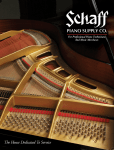
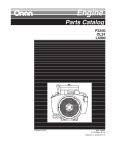
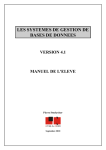
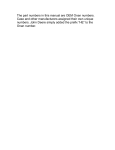
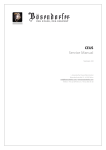
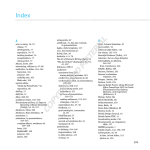
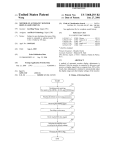
![T] .1](http://vs1.manualzilla.com/store/data/005831826_1-5c5b79be6c7f2f902c022f1ff12b7474-150x150.png)
